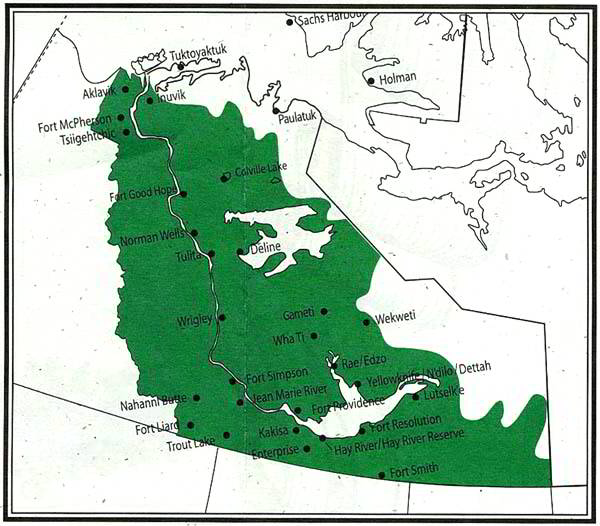Northwest Territories

There are approximately 33 million hectares of forest land in the Northwest Territories, representing 8% of Canada's entire forested area.This forested area is part of Canada's Boreal Forest Region.
 Thelon Wildlife
Sanctuary http://www.thelon.com/sanctuary.htm
Covering an area of approximately 26,000 sq. miles, the Thelon Wildlife Sanctuary, straddling the boundary of the Northwest Territories and Nunavut in Canada's mainland Arctic, is the largest and most remote wildlife refuge on the North America continent - and possibly the world. As there is little surrounding developments in this region, the unusual forest oasis located far out on the tundra truly represents one of the last great, unaltered ecosystems on our planet. For those few fortunate enough to have ever visited this extreme remote region, the experience is like stepping back to a time when grizzly, wolves and musk-ox ruled the earth... Thelon Wildlife
Sanctuary http://www.thelon.com/sanctuary.htm
Covering an area of approximately 26,000 sq. miles, the Thelon Wildlife Sanctuary, straddling the boundary of the Northwest Territories and Nunavut in Canada's mainland Arctic, is the largest and most remote wildlife refuge on the North America continent - and possibly the world. As there is little surrounding developments in this region, the unusual forest oasis located far out on the tundra truly represents one of the last great, unaltered ecosystems on our planet. For those few fortunate enough to have ever visited this extreme remote region, the experience is like stepping back to a time when grizzly, wolves and musk-ox ruled the earth...
 Government of the
Northwest Territories http://www.gov.nt.ca/
Government of the
Northwest Territories http://www.gov.nt.ca/
 Forest Management
Division of the Government of the Northwest Territories http://forestmanagement.enr.gov.nt.ca/
The Forest Management Division (FMD) provides the policy, planning and regulatory framework for the stewardship, protection and sustainable management of forest resources on 33 million hectares of land in the Northwest Territories, 8% of Canada's entire forested area. Working with First Nations governments, communities, other governments and non-governmental agencies on such a vast land mass, presents unique and complex challenges for forest managers. Forest Management
Division of the Government of the Northwest Territories http://forestmanagement.enr.gov.nt.ca/
The Forest Management Division (FMD) provides the policy, planning and regulatory framework for the stewardship, protection and sustainable management of forest resources on 33 million hectares of land in the Northwest Territories, 8% of Canada's entire forested area. Working with First Nations governments, communities, other governments and non-governmental agencies on such a vast land mass, presents unique and complex challenges for forest managers.
 Canada's Northwest
Territories Parks and Tourism http://www.gov.nt.ca/RWED/parks/education/p_t/trees_shrubs.htm
Trees and Shrubs: Many northern trees are still used in traditional ways by native people. White birch, collected when supple with Spring sap, is used to make snowshoe frames. Beautiful birch bark baskets, decorated with porcupine quills, are common in Mackenzie Valley communities.
Canada's Northwest
Territories Parks and Tourism http://www.gov.nt.ca/RWED/parks/education/p_t/trees_shrubs.htm
Trees and Shrubs: Many northern trees are still used in traditional ways by native people. White birch, collected when supple with Spring sap, is used to make snowshoe frames. Beautiful birch bark baskets, decorated with porcupine quills, are common in Mackenzie Valley communities.
 Wood Buffalo National
Park http://whc.unesco.org/sites/256.htm
UNESCO World Heritage Site. Situated on the plains in the
north-central region of Canada, the park (which covers 44,807 sq. km) is
home to North America's largest population of wild bison. It is also the
natural nesting place of the whooping crane. Another of the park's
attractions is the world's largest inland delta, located at the mouth of
the Peace and Athabasca rivers. Also see Parks Canada - Wood
Buffalo National Park http://www.pc.gc.ca/pn-np/nt/woodbuffalo/index_e.asp
Wood Buffalo National
Park http://whc.unesco.org/sites/256.htm
UNESCO World Heritage Site. Situated on the plains in the
north-central region of Canada, the park (which covers 44,807 sq. km) is
home to North America's largest population of wild bison. It is also the
natural nesting place of the whooping crane. Another of the park's
attractions is the world's largest inland delta, located at the mouth of
the Peace and Athabasca rivers. Also see Parks Canada - Wood
Buffalo National Park http://www.pc.gc.ca/pn-np/nt/woodbuffalo/index_e.asp
|